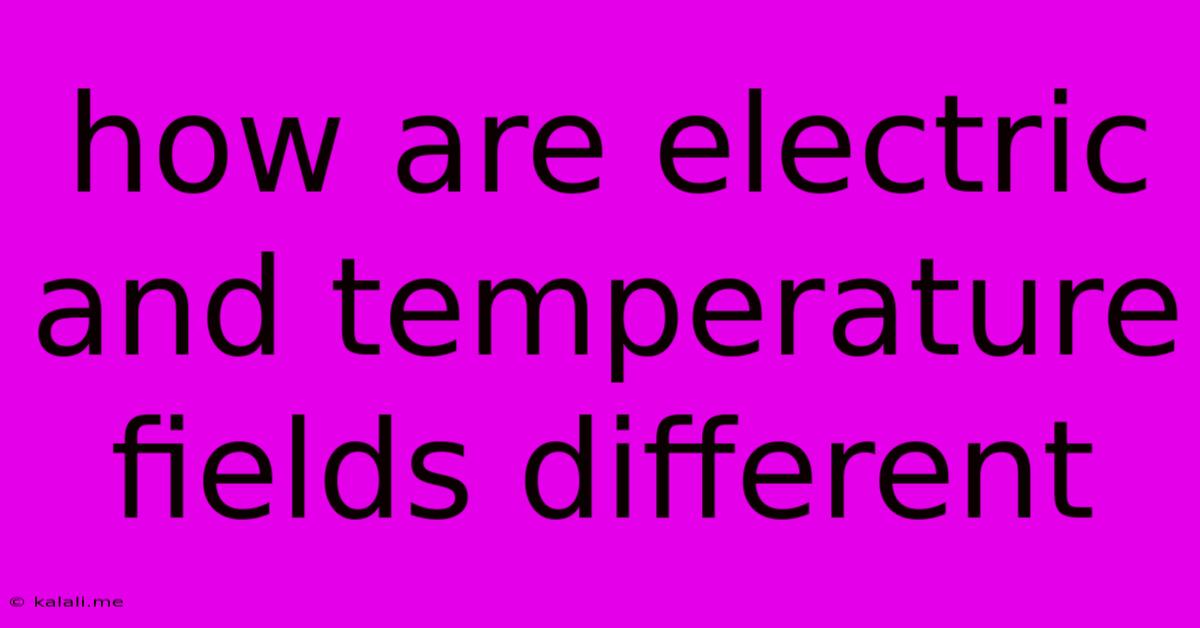How Are Electric And Temperature Fields Different
Kalali
Jun 09, 2025 · 3 min read

Table of Contents
How are Electric and Temperature Fields Different? A Comprehensive Comparison
Understanding the differences between electric and temperature fields is crucial in various scientific and engineering disciplines. While both are vector fields describing the spatial distribution of a physical quantity, their underlying mechanisms, interactions, and effects differ significantly. This article will delve into these key distinctions, exploring their nature, measurement, and applications.
Electric fields describe the force exerted on a charged particle, while temperature fields describe the average kinetic energy of particles within a material. This fundamental difference leads to a wide array of contrasting properties.
1. Underlying Physical Mechanisms
-
Electric Fields: These fields originate from electric charges and their interactions. A positive charge creates a field that points radially outward, while a negative charge creates a field pointing inward. The strength of the field is directly proportional to the magnitude of the charge and inversely proportional to the square of the distance from the charge (Coulomb's Law). Electric fields can be static (unchanging) or dynamic (changing over time), leading to phenomena like electromagnetic radiation.
-
Temperature Fields: These fields arise from the random thermal motion of particles within a substance. Higher temperatures correspond to greater average kinetic energy of these particles. Unlike electric fields, temperature fields aren't directly caused by a "source charge" but rather a distribution of thermal energy. Heat transfer, driven by temperature gradients, aims to equalize temperature differences throughout a system.
2. Nature of the Fields
-
Electric Fields: These are vector fields, meaning they have both magnitude (strength) and direction at each point in space. The direction indicates the force a positive test charge would experience if placed at that point. Electric fields can be easily manipulated and controlled using conductors, insulators, and various electromagnetic devices.
-
Temperature Fields: While temperature can be represented as a scalar field (having only magnitude at each point), heat transfer, driven by temperature differences, is a vector process. Heat flux, the rate of heat flow per unit area, is a vector quantity describing the direction and magnitude of heat transfer. Temperature fields are inherently more difficult to control, often requiring significant energy input or sophisticated thermal management techniques.
3. Measurement and Units
-
Electric Fields: Measured using instruments like electrometers, which detect the force exerted on a known charge. The unit of electric field strength is Volts per meter (V/m) or Newtons per Coulomb (N/C).
-
Temperature Fields: Measured using various thermometers and thermal imaging cameras, which detect the average kinetic energy of particles. Common temperature units include Celsius (°C), Fahrenheit (°F), and Kelvin (K).
4. Interactions with Matter
-
Electric Fields: Interact strongly with charged particles, causing them to accelerate. This interaction is the basis for many technologies, including electronics, electric motors, and particle accelerators. Electric fields can also induce polarization in materials, leading to dielectric effects.
-
Temperature Fields: Interact with matter through heat transfer mechanisms like conduction, convection, and radiation. Heat transfer affects the physical properties of materials, leading to thermal expansion, phase transitions, and chemical reactions.
5. Applications
-
Electric Fields: Widely used in numerous technologies, including power transmission, electronics, medical imaging (e.g., MRI), and particle physics.
-
Temperature Fields: Crucial in various applications, including material processing (e.g., heat treating), climate control, thermal management in electronics, and meteorological forecasting.
Conclusion
While both electric and temperature fields are crucial concepts in physics and engineering, they differ significantly in their fundamental mechanisms, nature, and interactions with matter. Electric fields arise from charges and exert forces on charged particles, while temperature fields arise from thermal motion and drive heat transfer. Understanding these distinctions is crucial for tackling diverse problems in various scientific and engineering domains.
Latest Posts
Latest Posts
-
How Much Does A Gallon Oil Weigh
Jul 01, 2025
-
How Many Crackers In A Sleeve Of Saltines
Jul 01, 2025
-
How Many Years Are In 48 Months
Jul 01, 2025
-
What Grade Is A 12 Out Of 15
Jul 01, 2025
-
The Opposite Of The Opposite Of Inexact Is
Jul 01, 2025
Related Post
Thank you for visiting our website which covers about How Are Electric And Temperature Fields Different . We hope the information provided has been useful to you. Feel free to contact us if you have any questions or need further assistance. See you next time and don't miss to bookmark.